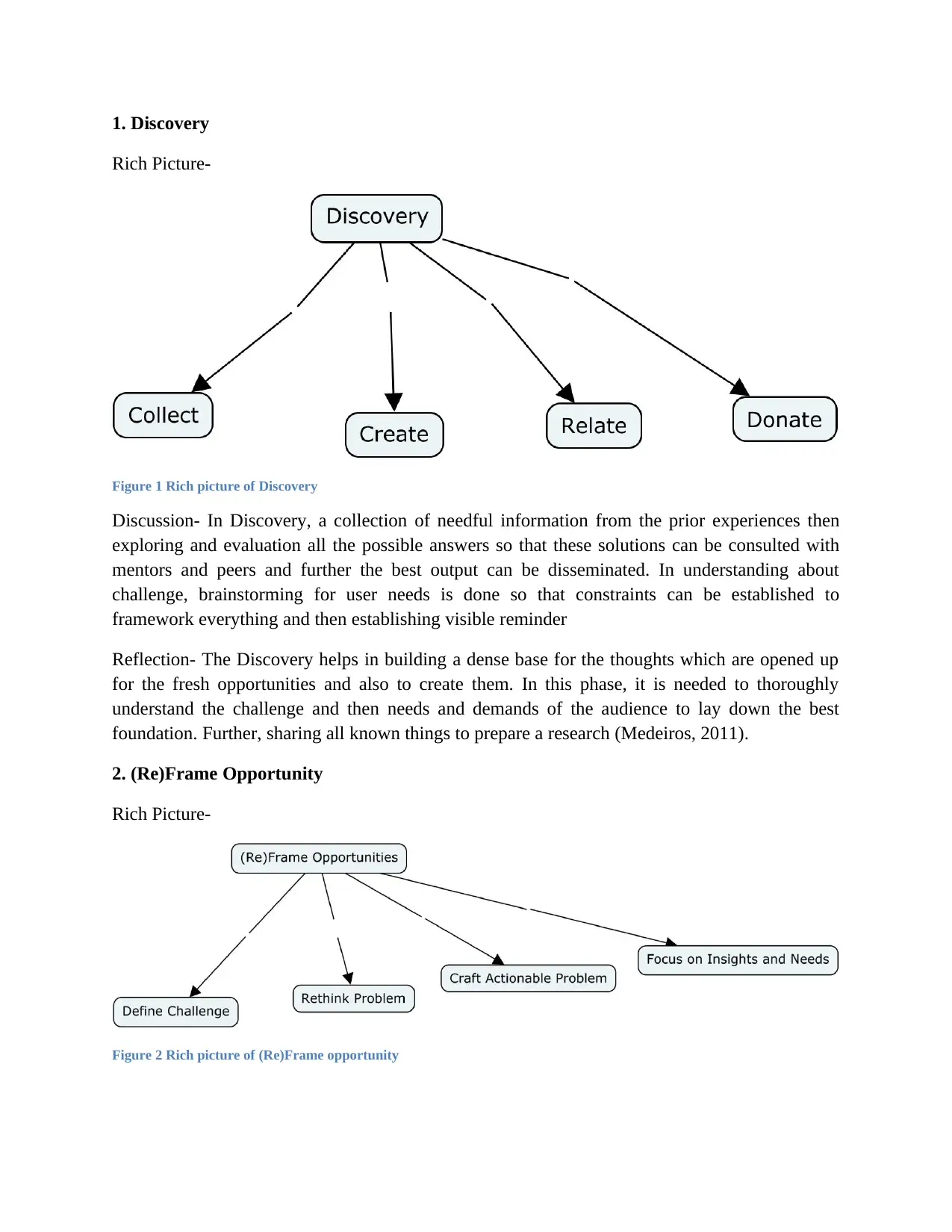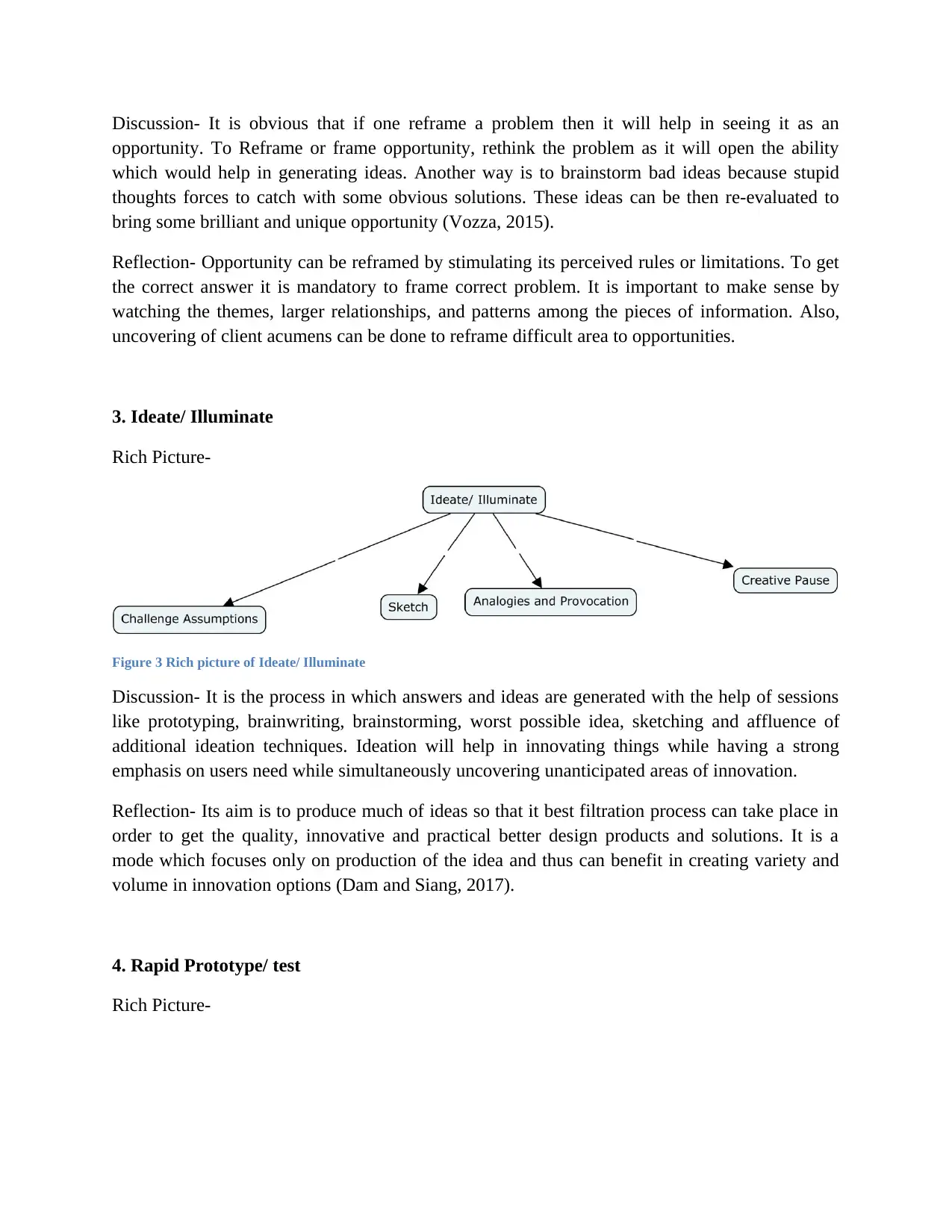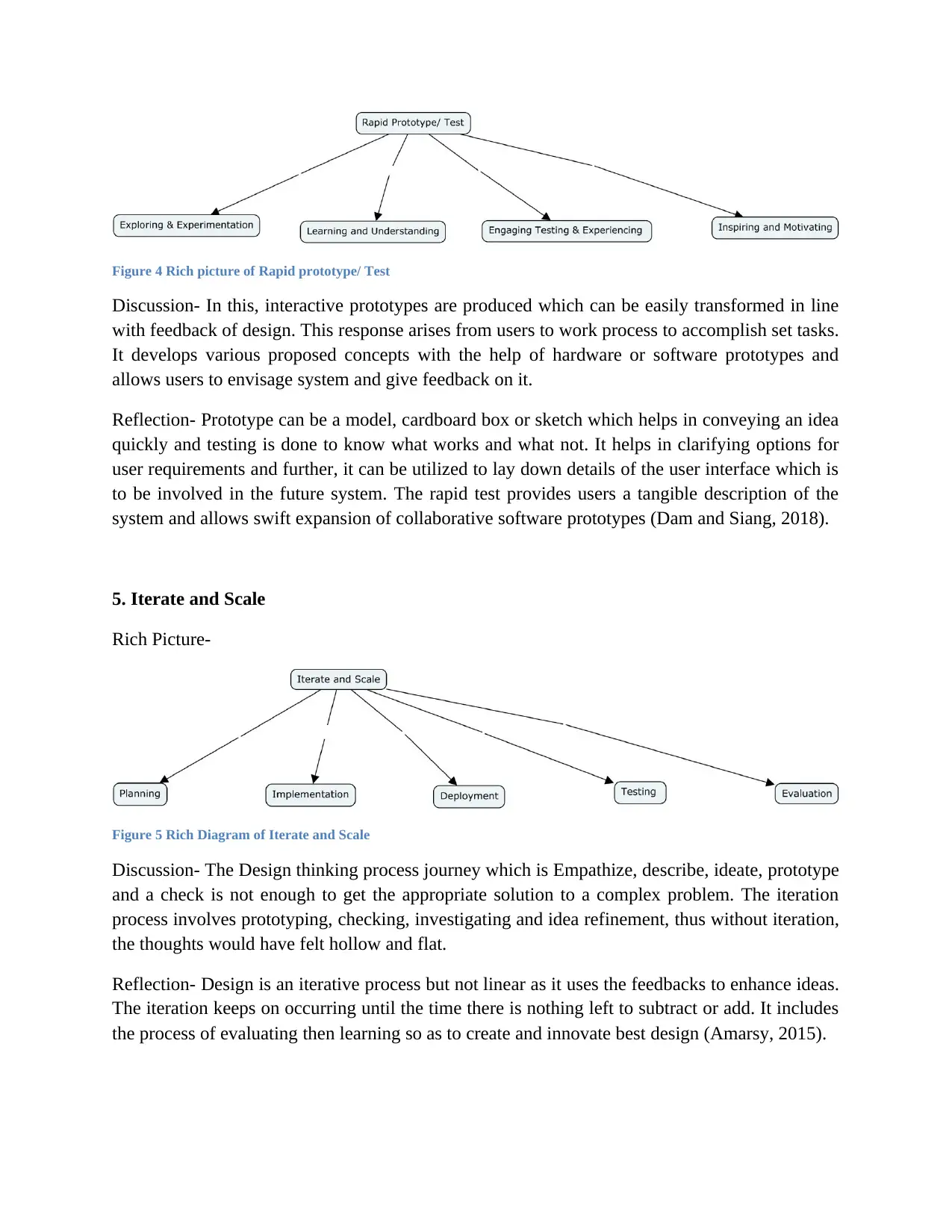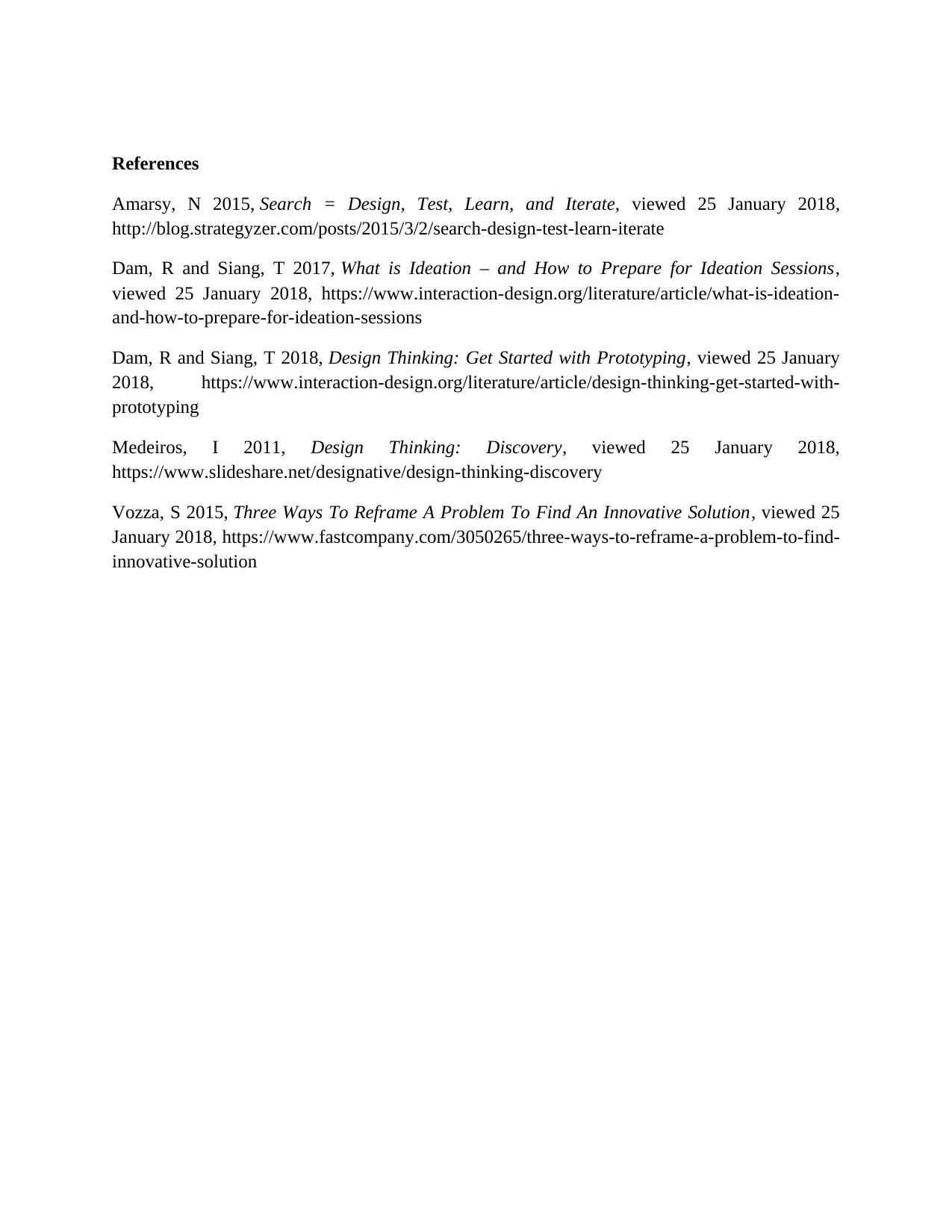Design Thinking: A Detailed Analysis of the Core Stages & Processes
VerifiedAdded on 2024/04/26
|4
|860
|446
Report
AI Summary
This report provides a detailed overview of the design thinking process, breaking it down into key stages: Discovery, (Re)Frame Opportunity, Ideate/Illuminate, Rapid Prototype/Test, and Iterate and Scale. The Discovery phase involves gathering information and brainstorming user needs to establish constraints. Reframing a problem allows for seeing it as an opportunity, stimulating idea generation. Ideation focuses on producing a multitude of ideas through various techniques like prototyping and brainstorming. Rapid prototyping involves creating interactive prototypes for user feedback and testing, while the Iterate and Scale stage emphasizes continuous improvement through feedback and refinement. The report highlights the importance of iteration in enhancing ideas and creating innovative designs, referencing various sources to support these concepts.

1. Discovery
Rich Picture-
Figure 1 Rich picture of Discovery
Discussion- In Discovery, a collection of needful information from the prior experiences then
exploring and evaluation all the possible answers so that these solutions can be consulted with
mentors and peers and further the best output can be disseminated. In understanding about
challenge, brainstorming for user needs is done so that constraints can be established to
framework everything and then establishing visible reminder
Reflection- The Discovery helps in building a dense base for the thoughts which are opened up
for the fresh opportunities and also to create them. In this phase, it is needed to thoroughly
understand the challenge and then needs and demands of the audience to lay down the best
foundation. Further, sharing all known things to prepare a research (Medeiros, 2011).
2. (Re)Frame Opportunity
Rich Picture-
Figure 2 Rich picture of (Re)Frame opportunity
Rich Picture-
Figure 1 Rich picture of Discovery
Discussion- In Discovery, a collection of needful information from the prior experiences then
exploring and evaluation all the possible answers so that these solutions can be consulted with
mentors and peers and further the best output can be disseminated. In understanding about
challenge, brainstorming for user needs is done so that constraints can be established to
framework everything and then establishing visible reminder
Reflection- The Discovery helps in building a dense base for the thoughts which are opened up
for the fresh opportunities and also to create them. In this phase, it is needed to thoroughly
understand the challenge and then needs and demands of the audience to lay down the best
foundation. Further, sharing all known things to prepare a research (Medeiros, 2011).
2. (Re)Frame Opportunity
Rich Picture-
Figure 2 Rich picture of (Re)Frame opportunity
Paraphrase This Document
Need a fresh take? Get an instant paraphrase of this document with our AI Paraphraser

Discussion- It is obvious that if one reframe a problem then it will help in seeing it as an
opportunity. To Reframe or frame opportunity, rethink the problem as it will open the ability
which would help in generating ideas. Another way is to brainstorm bad ideas because stupid
thoughts forces to catch with some obvious solutions. These ideas can be then re-evaluated to
bring some brilliant and unique opportunity (Vozza, 2015).
Reflection- Opportunity can be reframed by stimulating its perceived rules or limitations. To get
the correct answer it is mandatory to frame correct problem. It is important to make sense by
watching the themes, larger relationships, and patterns among the pieces of information. Also,
uncovering of client acumens can be done to reframe difficult area to opportunities.
3. Ideate/ Illuminate
Rich Picture-
Figure 3 Rich picture of Ideate/ Illuminate
Discussion- It is the process in which answers and ideas are generated with the help of sessions
like prototyping, brainwriting, brainstorming, worst possible idea, sketching and affluence of
additional ideation techniques. Ideation will help in innovating things while having a strong
emphasis on users need while simultaneously uncovering unanticipated areas of innovation.
Reflection- Its aim is to produce much of ideas so that it best filtration process can take place in
order to get the quality, innovative and practical better design products and solutions. It is a
mode which focuses only on production of the idea and thus can benefit in creating variety and
volume in innovation options (Dam and Siang, 2017).
4. Rapid Prototype/ test
Rich Picture-
opportunity. To Reframe or frame opportunity, rethink the problem as it will open the ability
which would help in generating ideas. Another way is to brainstorm bad ideas because stupid
thoughts forces to catch with some obvious solutions. These ideas can be then re-evaluated to
bring some brilliant and unique opportunity (Vozza, 2015).
Reflection- Opportunity can be reframed by stimulating its perceived rules or limitations. To get
the correct answer it is mandatory to frame correct problem. It is important to make sense by
watching the themes, larger relationships, and patterns among the pieces of information. Also,
uncovering of client acumens can be done to reframe difficult area to opportunities.
3. Ideate/ Illuminate
Rich Picture-
Figure 3 Rich picture of Ideate/ Illuminate
Discussion- It is the process in which answers and ideas are generated with the help of sessions
like prototyping, brainwriting, brainstorming, worst possible idea, sketching and affluence of
additional ideation techniques. Ideation will help in innovating things while having a strong
emphasis on users need while simultaneously uncovering unanticipated areas of innovation.
Reflection- Its aim is to produce much of ideas so that it best filtration process can take place in
order to get the quality, innovative and practical better design products and solutions. It is a
mode which focuses only on production of the idea and thus can benefit in creating variety and
volume in innovation options (Dam and Siang, 2017).
4. Rapid Prototype/ test
Rich Picture-

Figure 4 Rich picture of Rapid prototype/ Test
Discussion- In this, interactive prototypes are produced which can be easily transformed in line
with feedback of design. This response arises from users to work process to accomplish set tasks.
It develops various proposed concepts with the help of hardware or software prototypes and
allows users to envisage system and give feedback on it.
Reflection- Prototype can be a model, cardboard box or sketch which helps in conveying an idea
quickly and testing is done to know what works and what not. It helps in clarifying options for
user requirements and further, it can be utilized to lay down details of the user interface which is
to be involved in the future system. The rapid test provides users a tangible description of the
system and allows swift expansion of collaborative software prototypes (Dam and Siang, 2018).
5. Iterate and Scale
Rich Picture-
Figure 5 Rich Diagram of Iterate and Scale
Discussion- The Design thinking process journey which is Empathize, describe, ideate, prototype
and a check is not enough to get the appropriate solution to a complex problem. The iteration
process involves prototyping, checking, investigating and idea refinement, thus without iteration,
the thoughts would have felt hollow and flat.
Reflection- Design is an iterative process but not linear as it uses the feedbacks to enhance ideas.
The iteration keeps on occurring until the time there is nothing left to subtract or add. It includes
the process of evaluating then learning so as to create and innovate best design (Amarsy, 2015).
Discussion- In this, interactive prototypes are produced which can be easily transformed in line
with feedback of design. This response arises from users to work process to accomplish set tasks.
It develops various proposed concepts with the help of hardware or software prototypes and
allows users to envisage system and give feedback on it.
Reflection- Prototype can be a model, cardboard box or sketch which helps in conveying an idea
quickly and testing is done to know what works and what not. It helps in clarifying options for
user requirements and further, it can be utilized to lay down details of the user interface which is
to be involved in the future system. The rapid test provides users a tangible description of the
system and allows swift expansion of collaborative software prototypes (Dam and Siang, 2018).
5. Iterate and Scale
Rich Picture-
Figure 5 Rich Diagram of Iterate and Scale
Discussion- The Design thinking process journey which is Empathize, describe, ideate, prototype
and a check is not enough to get the appropriate solution to a complex problem. The iteration
process involves prototyping, checking, investigating and idea refinement, thus without iteration,
the thoughts would have felt hollow and flat.
Reflection- Design is an iterative process but not linear as it uses the feedbacks to enhance ideas.
The iteration keeps on occurring until the time there is nothing left to subtract or add. It includes
the process of evaluating then learning so as to create and innovate best design (Amarsy, 2015).
⊘ This is a preview!⊘
Do you want full access?
Subscribe today to unlock all pages.

Trusted by 1+ million students worldwide

References
Amarsy, N 2015, Search = Design, Test, Learn, and Iterate, viewed 25 January 2018,
http://blog.strategyzer.com/posts/2015/3/2/search-design-test-learn-iterate
Dam, R and Siang, T 2017, What is Ideation – and How to Prepare for Ideation Sessions,
viewed 25 January 2018, https://www.interaction-design.org/literature/article/what-is-ideation-
and-how-to-prepare-for-ideation-sessions
Dam, R and Siang, T 2018, Design Thinking: Get Started with Prototyping, viewed 25 January
2018, https://www.interaction-design.org/literature/article/design-thinking-get-started-with-
prototyping
Medeiros, I 2011, Design Thinking: Discovery, viewed 25 January 2018,
https://www.slideshare.net/designative/design-thinking-discovery
Vozza, S 2015, Three Ways To Reframe A Problem To Find An Innovative Solution, viewed 25
January 2018, https://www.fastcompany.com/3050265/three-ways-to-reframe-a-problem-to-find-
innovative-solution
Amarsy, N 2015, Search = Design, Test, Learn, and Iterate, viewed 25 January 2018,
http://blog.strategyzer.com/posts/2015/3/2/search-design-test-learn-iterate
Dam, R and Siang, T 2017, What is Ideation – and How to Prepare for Ideation Sessions,
viewed 25 January 2018, https://www.interaction-design.org/literature/article/what-is-ideation-
and-how-to-prepare-for-ideation-sessions
Dam, R and Siang, T 2018, Design Thinking: Get Started with Prototyping, viewed 25 January
2018, https://www.interaction-design.org/literature/article/design-thinking-get-started-with-
prototyping
Medeiros, I 2011, Design Thinking: Discovery, viewed 25 January 2018,
https://www.slideshare.net/designative/design-thinking-discovery
Vozza, S 2015, Three Ways To Reframe A Problem To Find An Innovative Solution, viewed 25
January 2018, https://www.fastcompany.com/3050265/three-ways-to-reframe-a-problem-to-find-
innovative-solution
1 out of 4
Related Documents
Your All-in-One AI-Powered Toolkit for Academic Success.
+13062052269
info@desklib.com
Available 24*7 on WhatsApp / Email
![[object Object]](/_next/static/media/star-bottom.7253800d.svg)
Unlock your academic potential
Copyright © 2020–2025 A2Z Services. All Rights Reserved. Developed and managed by ZUCOL.


